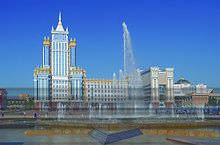Mordovian State University
N. P. Ogarev's Mordovia State University (MSUO or OMSU for Ogarev Mordovia State University, or MRSU for Мордовский государственный университет имени Н. П. Огарева, Mordovskyi Gosudarstvennyi Universitet (imeni N. P. Ogareva)) is located in the city of Saransk, the capital of the Republic of Mordovia, Russia. It was established in October 1957 as an expansion of the Mordovian National Pedagogical Institute, established in 1931. The University offers bachelor's and master's degrees in various academic fields.
Национальный исследовательский Мордовский государственный университет имени Н. П. Огарёва | |
 | |
| Established | 1957 |
|---|---|
| Location | , 54°11′14″N 45°10′53″E |
| Website | mrsu.ru |
The courses are available in the form of full-time education, evening (part-time) curriculum, and correspondence education (6 years). The medical faculty offers 6 and 7-year programs of study.
The total student body numbers approximately 28,000 students, including international students from countries like India, Pakistan, Bangladesh, Kuwait, Oman, Iran, Iraq, Saudi, UAE and few African countries.
Units
Academic disciplines are offered through following academic structural units:
Academic department
- Biology,
- Medicine,
- Philology,
- Foreign Languages (English, German, French),
- Geography,
- Law / Jurisprudence,
- Economics,
- National (Mordvin) Culture,
- Civil Engineering and Building Constructions,
- Lighting Technology,
- Electronics,
- Academic Skills College.
Colleges (institutes)
- Physics and Chemistry Institute
- History and Sociology Institute
- Mechanics and Power Engineering Institute
- Agrarian Institute
- Machine Building Institute (Ruzayevka campus )
- Institute for Supplementary Training and Qualification Improvement with
A range of related faculties are grouped within the Inter-branch Regional Centre for Supplementary Training.
In addition, University divisions in other towns of Mordovia provide for educating facilities in Economics and Law Studies.
External links
- MRSU homepage, in Russian
- MRSU International Relations Office, in English